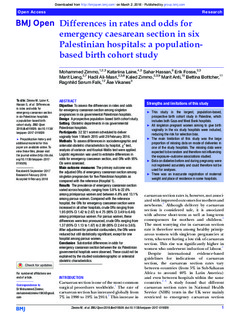| dc.description.abstract | Objective To assess the differences in rates and odds for emergency caesarean section among singleton pregnancies in six governmental Palestinian hospitals.
Design A prospective population-based birth cohort study.
Setting Obstetric departments in six governmental Palestinian hospitals.
Participants 32 321 women scheduled to deliver vaginally from 1 March 2015 until 29 February 2016.
Methods To assess differences in sociodemographic and antenatal obstetric characteristics by hospital, χ2 test, analysis of variance and Kruskal-Wallis test were applied. Logistic regression was used to estimate differences in odds for emergency caesarean section, and ORs with 95% CIs were assessed.
Main outcome measures The primary outcome was the adjusted ORs of emergency caesarean section among singleton pregnancies for five Palestinian hospitals as compared with the reference (Hospital 1).
Results The prevalence of emergency caesarean section varied across hospitals, ranging from 5.8% to 22.6% among primiparous women and between 4.8% and 13.1% among parous women. Compared with the reference hospital, the ORs for emergency caesarean section were increased in all other hospitals, crude ORs ranging from 1.95 (95% CI 1.42 to 2.67) to 4.75 (95% CI 3.49 to 6.46) among primiparous women. For parous women, these differences were less pronounced, crude ORs ranging from 1.37 (95% CI 1.13 to 1.67) to 2.99 (95% CI 2.44 to 3.65). After adjustment for potential confounders, the ORs were reduced but still statistically significant, except for one hospital among parous women.
Conclusion Substantial differences in odds for emergency caesarean section between the six Palestinian governmental hospitals were observed. These could not be explained by the studied sociodemographic or antenatal obstetric characteristics. | nb_NO |

